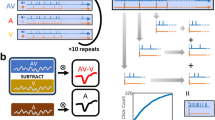Abstract—
We have compared the effects of open-loop and closed-loop audio–visual stimulation (AVS) generated on-line on the basis of subjects’ bioelectrical activity. In the first experiment, volunteers were presented with closed-loop AVS consisting of photic- and music-like stimuli generated by transformation of the current parameters of subjects’ electroencephalogram (EEG) and heart rhythm. In the second experiment, prearranged composition of photic and musical stimuli was used without feedback from the current bioelectric activity of the subjects. It has been found that the most pronounced shifts in objective and subjective indicators, such as the maximum increase in the EEG α rhythm power relative to the background, positive emotional reactions, and shifts in the functional state of the body, are recorded when AVS is controlled by the current electrophysiological characteristics of the subjects. These effects result from the involvement of interoceptive mechanisms in the system of mechanisms responsible for normalization of human functional state under AVS, i.e., the mechanisms of multisensory integration and neuroplasticity and the resonance mechanisms of the brain.
Similar content being viewed by others
REFERENCES
Golovin, M.S., Balioz, N.V., Aizman, R.I., and Krivoshchekov, S.G., Effect of audiovisual stimulation on the psychophysiological functions in track-and-field athletes, Hum. Physiol., 2015, vol. 41, no. 5, p. 532.
Golovin, M.S., Balioz, N.V., Krivoschekov, S.G., and Aizman, R.I., Integration of functional, psychophysiological, and biochemical processes in athletes after audiovisual stimulation, Hum. Physiol., 2018, vol. 44, no. 1, p. 54.
Glazachev, O.S., Klassina, S.Ya., Bobyleva, O.V., and Klassnja, A., Effects of polymodal rhythmic sensory influences on the human CNS state and autonomic functions, Hum. Physiol., 2010, vol. 36, no. 2, p. 172.
Arabi, L.S., Sysoev, V.N., and Kremneva, T.V., Audio-visual stimulation in comprehensive treatment of psychosomatic diseases, Vestn. Psikhoter., 2011, no. 39 (44), p. 9.
Ashanina, E.N. and Kulakov, D.V., Effectiveness of partial audiovisual impact and biological feedback for correction of desadaptive mental states of specialists of extreme professions, Vestn. Psikhoter., 2011, no. 39 (44), p. 85.
Tang, H.Y., Vitiello, M.V., Perlis, M., and Riegel, B., Open-loop neurofeedback audiovisual stimulation: A pilot study of its potential for sleep induction in older adults, Appl. Psychophysiol. Biofeedback, 2015, vol. 40, no. 3, p. 183.
Tang, H.Y., Riegel, B., McCurry, S.M., and Vitiello, M.V., Open-loop audio-visual stimulation (AVS): A useful tool for management of insomnia? Appl. Psychophysiol. Biofeedback, 2016, vol. 41, no. 1, p. 39.
Sitaram, R., Ros, T., Stoeckel, L., et al., Closed-loop brain training: the science of neurofeedback, Nat. Rev. Neurosci., 2017, vol. 18, no. 2, p. 86.
Tegeler, C.H., Cook, J.F., Tegeler, C.L., et al., Clinical, hemispheric, and autonomic changes associated with use of closed-loop, allostatic neurotechnology by a case series of individuals with self-reported symptoms of post-traumatic stress, BMC Psychiatry, 2017, vol. 17, no. 1, p. 141.
Levi, T., Bonifazi, P., Massobrio, P., and Chiappalone, M., Editorial: Closed-loop systems for next-generation neuroprostheses, Front. Neurosci., 2018, vol. 12, p. 26.
Fedotchev, A.I., Bondar’, A.T., and Semenov, V.S., Efficiency of photostimulation controlled by subject’s EEG decreases under the conditions of feedback delay, Hum. Physiol., 2016, vol. 42, no. 4, p. 381.
Fedotchev, A.I., Zhuravlev, G.I., Eksina, K.I., et al., Evaluation of efficiency of musical EEG neurointerface with additional control contour from heart rhythm, Ross. Fiziol. Zh. im. I.M. Sechenova, 2018, vol. 104, no. 1, p. 122.
Kataev, A.A., Bakhchina, A.V., Polevaya, S.A., and Fedotchev, A.I. Connection between subjective and objective estimates of human functional state (approbation of rapid test for measurement of stress level), Vestn. Psikhofiziol., 2017, no. 2, p. 62.
Polevaya, S.A., Nekrasova, M.M., Runova, E.V., et al., Discrete monitoring and telemetry of the cardiac rhythm during working on a computer to assess and prevent fatigue and stress, Med. Al’m., 2013, no. 2 (26), p. 151.
Fedotchev, A.I., Bondar’, A.T., Bakhchina, A.V., et al., Music-acoustic signals controlled by subject’s brain potentials in the correction of unfavorable functional states, Usp. Fiziol. Nauk, 2016, vol. 47, no. 1, p. 67.
Rao, A.R., An oscillatory neural network model that demonstrates the benefits of multisensory learning, Cognit. Neurodyn., 2018, vol. 12, no. 5, p. 481.
Maes, P.J., Buhmann, J., and Leman, M., 3Mo: A model for music-based biofeedback, Front. Neurosci., 2016, vol. 10, no. 548, p. 1.
Quadt, L., Critchley, H.D., and Garfinkel, S.N., The neurobiology of interoception in health and disease, Ann. N.Y. Acad. Sci., 2018, vol. 1428, no. 1, p. 112.
Lo, M.C. and Widge, A.S., Closed-loop neuromodulation systems: next-generation treatments for psychiatric illness, Int. Rev. Psychiatry, 2017, vol. 29, no. 2, p. 191.
Piradov, M.A., Chernikova, L.A., and Supone-va, N.A., Brain plasticity and modern neurorehabilitation technologies, Herald Russ. Acad. Sci., 2018, vol. 88, no. 2, p. 111.
ACKNOWLEDGMENTS
We are grateful to Vitaliy Semenovich Semenov, Chief Expert of the Institute of Cell Biophysics (Russian Academy of Sciences, Pushchino), for his assistance in software development.
Funding
This study was supported by the Russian Foundation for Basic Research, project nos. 18-013-01225, 18-413-520 006, and 19-013-00095.
Author information
Authors and Affiliations
Corresponding author
Ethics declarations
Conflict of interests. The authors declare that they have no conflict of interest.
Statement of compliance with standards of research involving humans as subjects. All procedures performed in studies involving human participants were in accordance with the 1964 Helsinki Declaration and its later amendments or comparable ethical standards and with the ethical standards of the Bioethics Committee of the Institute of Cell Biophysics, Russian Academy of Sciences (Pushchino). Informed consent was obtained from all individual participants involved in the study.
Additional information
Translated by E.V. Makeeva
Rights and permissions
About this article
Cite this article
Fedotchev, A.I., Parin, S.B., Polevaya, S.A. et al. Effects of Audio–Visual Stimulation Automatically Controlled by the Bioelectric Potentials from Human Brain and Heart. Hum Physiol 45, 523–526 (2019). https://doi.org/10.1134/S0362119719050025
Received:
Revised:
Accepted:
Published:
Issue Date:
DOI: https://doi.org/10.1134/S0362119719050025




